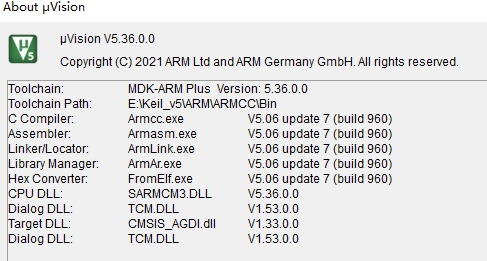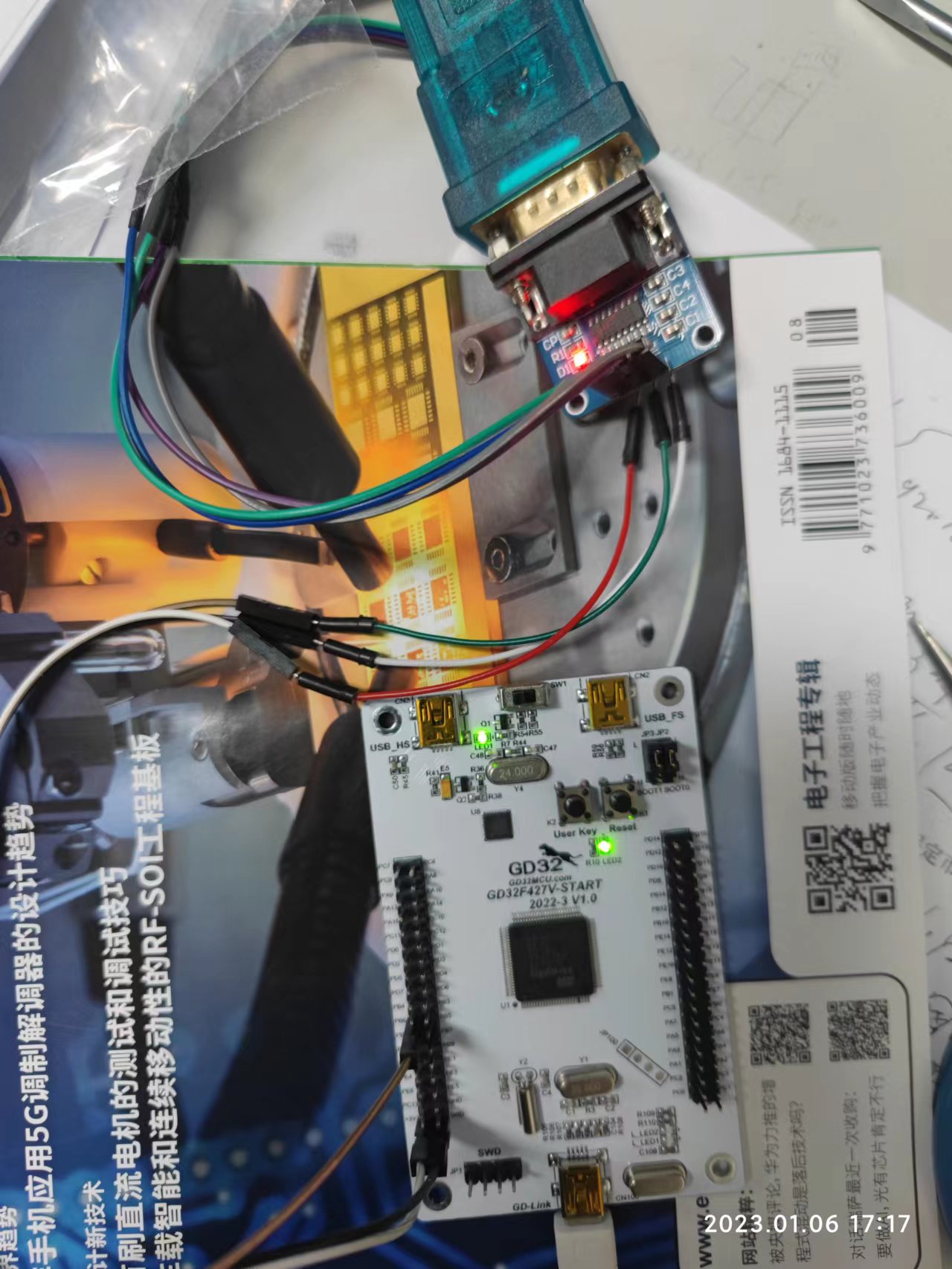简介
GD32F4系列MCU采用Arm® Cortex®-M4内核可支持算法复杂度更高的嵌入式应用,具备更快速的实时处理能力,很幸运能够有机会试用兆易公司的GD32F427V-START开发板。本次使用中,我将使用开发板测试之前使用过的DFT计算,采用定时器计算完成运算所用的时间,通过串口显示运算完成的时间。
软件环境
- 编程环境
keil-MDK 5.36(Windows10)
串口工具 参考资料
设计说明
主要是利用GD32F427这个测试板,将之前在STM32F1系列上的一些运算搬移到到这个上面来通过模拟的数据量(本次测试没有经过实际的采样,利用已知的数据进行测试),进行DFT运算,通过1组数据运算和60组数据的运算来评估一下运算的时间,从而验证在实际运行中能满足产品的计算要求。
硬件需求分析
本次用到的硬件有TIMER1,USART0,GPIO等硬件资源。
- TIMER1 计算运算的时间。
USART0 波特率9600,发送显示计算时间
代码
///////////////////////////////////////////////////////////// include "gd32f4xx.h" include "gd32f427v_start.h" include "systick.h" include "stdio.h" include "math.h" include "stdint.h" //数据类型定义 typedef unsigned char boolen; typedef unsigned char u8; /* Unsigned 8 bit quantity */ typedef signed char s8; /* Signed 8 bit quantity */ typedef unsigned short u16; /* Unsigned 16 bit quantity */ typedef signed short s16; /* Signed 16 bit quantity */ typedef unsigned long u32; /* Unsigned 32 bit quantity */ typedef signed long s32; /* Signed 32 bit quantity */ typedef float f32; /* Signed 32 bit quantity */ extern u8 times; u16 sample_date[32][6]; void rcu_set(void) { rcu_periph_clock_enable(RCU_GPIOB); rcu_periph_clock_enable(RCU_GPIOC); rcu_periph_clock_enable(RCU_TIMER1); rcu_periph_clock_enable(RCU_USART0); } //usart0设置 void usart0_set(void) { /* USART configure */ usart_deinit(USART0); usart_baudrate_set(USART0, 9600U); usart_receive_config(USART0, USART_RECEIVE_ENABLE); usart_transmit_config(USART0, USART_TRANSMIT_ENABLE); usart_enable(USART0); } //timer1设置(作为计时器用,查看计算时间,评估计算速度,1cnt = 0.001ms) void timer1_set(void) { timer_parameter_struct timer_initpara; /* TIMER1 configuration */ timer_deinit(TIMER1); timer_initpara.prescaler = 99; timer_initpara.alignedmode = TIMER_COUNTER_EDGE; timer_initpara.counterdirection = TIMER_COUNTER_UP; timer_initpara.period = 1000000; //计数值 timer_initpara.clockdivision = TIMER_CKDIV_DIV1; timer_initpara.repetitioncounter = 0; // timer_auto_reload_shadow_enable(TIMER1);// timer_init(TIMER1,&timer_initpara); } void gpio_init() { /* configure LED2 GPIO port */ gpio_mode_set(GPIOC, GPIO_MODE_OUTPUT, GPIO_PUPD_NONE, GPIO_PIN_6); gpio_output_options_set(GPIOC, GPIO_OTYPE_PP, GPIO_OSPEED_50MHZ, GPIO_PIN_6); //usart0串口设置PB6 /* connect port to USARTx_Tx */ gpio_af_set(GPIOB, GPIO_AF_7, GPIO_PIN_6); /* connect port to USARTx_Rx */ gpio_af_set(GPIOB, GPIO_AF_7, GPIO_PIN_7); /* configure USART Tx as alternate function push-pull */ gpio_mode_set(GPIOB, GPIO_MODE_AF, GPIO_PUPD_PULLUP, GPIO_PIN_6); gpio_output_options_set(GPIOB, GPIO_OTYPE_PP, GPIO_OSPEED_50MHZ, GPIO_PIN_6); /* configure USART Rx as alternate function push-pull */ gpio_mode_set(GPIOB, GPIO_MODE_AF, GPIO_PUPD_PULLUP, GPIO_PIN_7); gpio_output_options_set(GPIOB, GPIO_OTYPE_PP, GPIO_OSPEED_50MHZ, GPIO_PIN_7); } int main(void) { uint32_t cnt1_timer = 0; uint32_t cnt2_timer = 0; uint32_t cnt_timer = 0; u8 i = 0; SystemInit(); /* configure systick */ systick_config(); rcu_set(); gpio_init(); usart0_set(); timer1_set(); timer_enable(TIMER1); advalue(); while(1) { /* turn on LED2*/ gpio_bit_set(GPIOC, GPIO_PIN_6); /*AD sample */ timer_counter_value_config(TIMER1,0); fft(addate); cnt_timer = timer_counter_read(TIMER1); printf("Dft-time1: %ld",cnt_timer); delay_1ms(1000); /*AD sample */ timer_counter_value_config(TIMER1,0); for(i = 0; i <64; i++) { fft(addate); } cnt_timer = timer_counter_read(TIMER1); printf("Dft-time64: %ld",cnt_timer); /*AD count*/ delay_1ms(1000); /* turn off LED2 */ gpio_bit_reset(GPIOC, GPIO_PIN_6); } }计算结果以及分析
通过串口发送数据我们发现
单次运算计数为: 15
64次运算计数为: 976
每个计数单位的时间为0.001ms
单次运算时间为: 0.015ms
64次运算时间为: 0.976ms
可以看出,我们计算64组数据的时间不到1ms那么也就意味着我们可以同时监测更多的通道。
我们电力上的交流信号频率为50Hz,周期为20ms,在单一周期内可以完全计算出本次周波的幅值大小,并留出进行相关的记录和分析的充足时间。
总结
通过本次测试,GD32F427芯片能够满足实时采样计算的需求,主频能达到200MHz,相比之前用的STM32F1系列单片机,综合性能上有很大提高。比较适合做一些实时监测的产品。在当前形势下,国产arm芯片肯定是设计中的首选,在满足需求的前提下,我们优先选择国产,这样大概率能阻挡芯片缺货的风险。希望在今后的设计生产中早日批量使用GD产品,在批量生产中去验证产品的稳定性。感谢极数小姐姐在此次活动的帮助,由于本人水平有限,本文有错误和欠妥之处望大家批评指正,不吝赐教。






